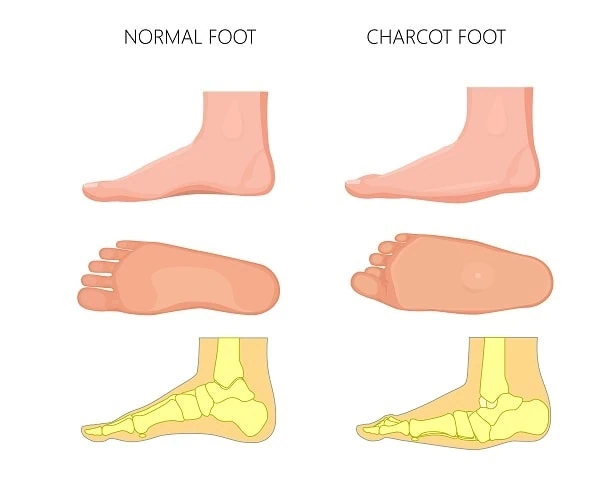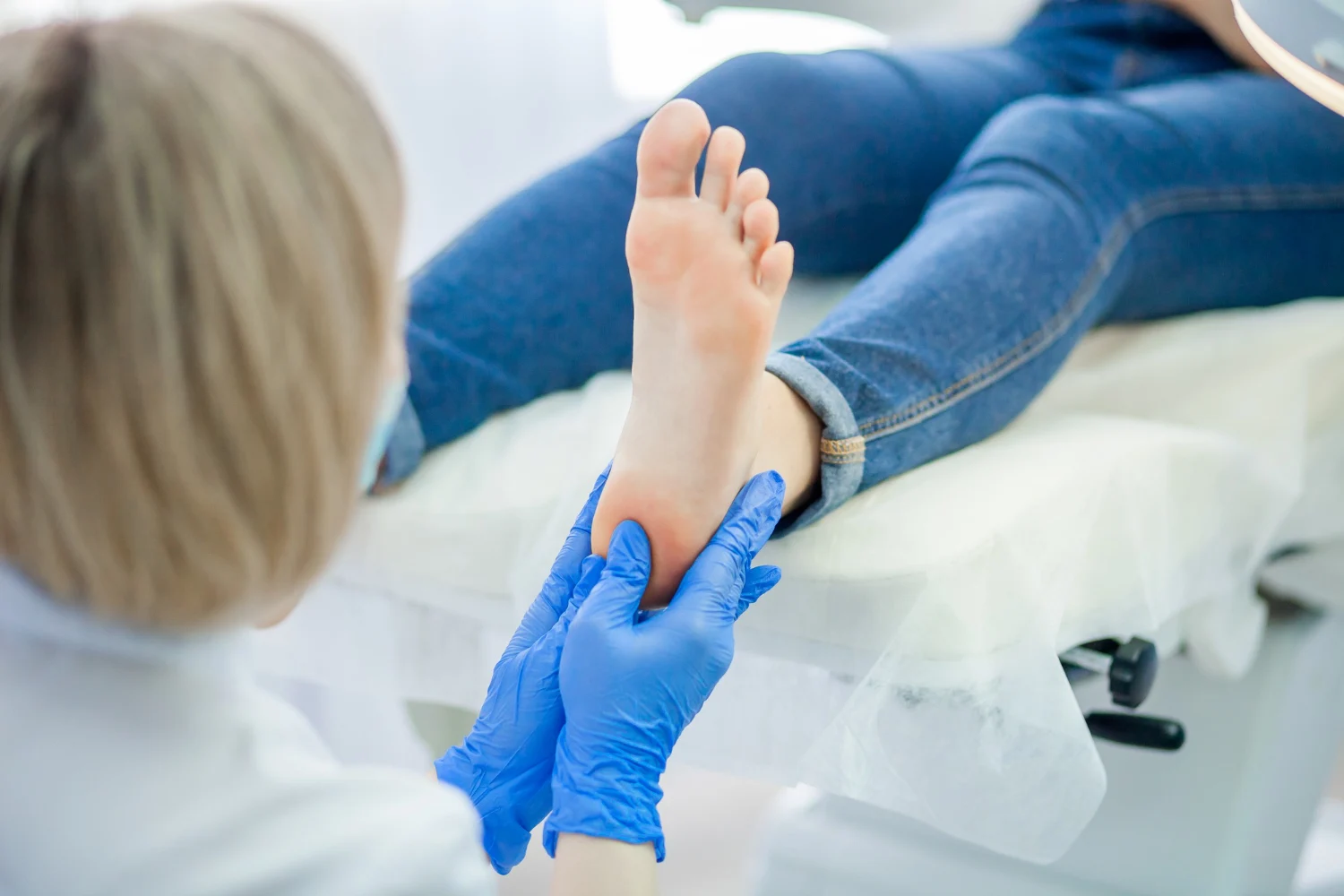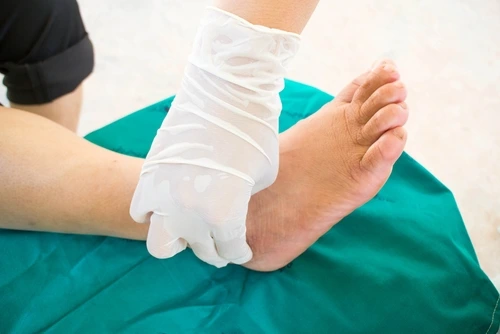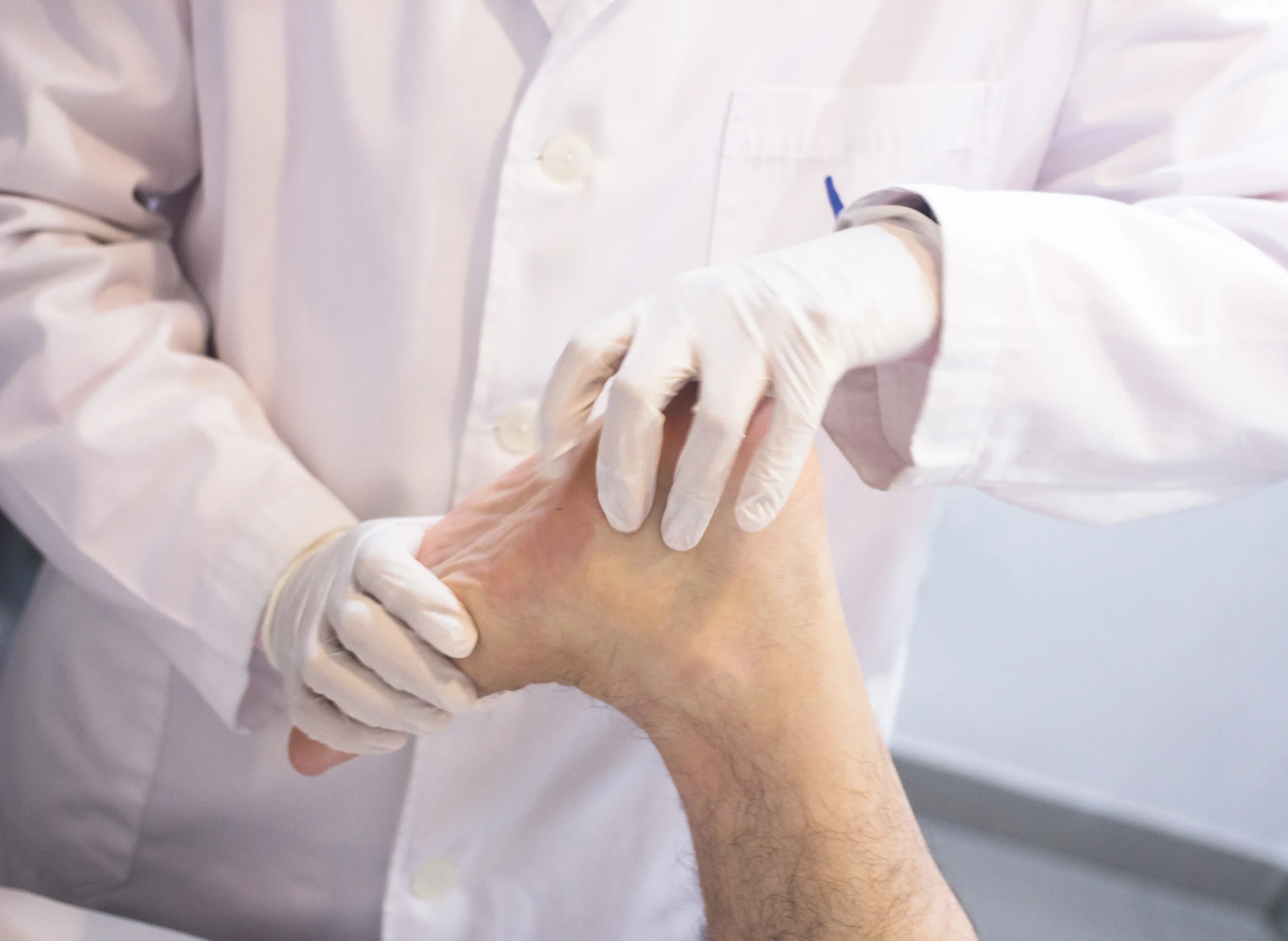
Diabetic Foot Care
Charcot Foot
Book Your Visit Now
The condition Charcot (pronounced “sharko”) foot is one of the most serious foot problems a diabetic can face.
Charcot foot, pronounced as “sharko” foot, represents one of the most severe and concerning complications that can afflict individuals with diabetes. This condition arises due to a complex interplay of factors and poses significant risks to the affected foot.
At its core, Charcot foot is characterized by the fracturing and disintegration of the bones within the foot, which leads to a profound alteration in the foot’s shape. What sets it apart from many other conditions is the absence of pain sensation in the affected foot. This lack of pain perception is a direct consequence of diabetic neuropathy, a common diabetic complication in which nerves are damaged, impairing their ability to transmit pain signals.
The absence of pain can initially appear as a relief for individuals, as they do not experience the discomfort typically associated with a fractured foot. However, this apparent relief is deceptive, as it leads to a dangerous scenario where the person remains unaware of the damage occurring within the foot. Consequently, they continue to bear weight on the affected foot and engage in everyday activities without realizing the extent of the injury.
This continued pressure and stress on the already weakened and fragile bones exacerbate the disintegration and deformity of the foot. Over time, the foot can become severely misshapen, leading to debilitating consequences and a heightened risk of further complications such as ulcers, infections, and even amputation.
The insidious nature of Charcot foot underscores the critical importance of regular foot monitoring for individuals with diabetes. Early detection and intervention are essential for preventing the progression of this condition. Prompt medical attention, including immobilization and offloading of the affected foot, is crucial to halt the destructive cycle and protect the foot from further harm.
Book Your Visit Now
What are the Symptoms and Causes of Charcot Foot?
Charcot foot is a condition commonly seen in individuals with peripheral neuropathy, particularly those with diabetes. if you’re wondering what the primary causes of Charcot foot are, they are explained in detail below:

Peripheral Neuropathy

Repetitive Trauma or Minor Injuries

Poor Blood Supply

Infection

Inflammatory Conditions
Get In Touch
Early diagnosis and intervention are critical to managing Charcot foot. Treatment focuses on offloading pressure from the affected foot, immobilization, and addressing underlying conditions like diabetes and neuropathy to prevent further damage and complications, as explained in the paragraphs below.
Treatment
Treatment for Charcot foot is primarily aimed at preventing further damage, supporting the affected foot, and addressing any deformity that may have developed. The chosen treatment approach will depend on the severity of the condition and the specific needs of the patient.
• Supportive Shoes: Supportive footwear plays a crucial role in managing Charcot foot. These shoes are specially designed to provide stability and reduce pressure on the affected foot. They are often equipped with custom orthotic inserts that help distribute weight evenly and alleviate stress on the fragile bones. Supportive shoes are essential for preventing further damage and promoting the healing process.
• Braces: In less severe cases or during the early stages of Charcot foot, braces may be prescribed. These orthotic devices are tailored to the individual’s foot shape and offer added support and stability. Braces help immobilize the foot, preventing excessive movement that could exacerbate the condition. They are an important component of conservative management.
• Reconstructive Surgery: In cases where the deformity is advanced and conservative measures are insufficient, reconstructive surgery may be considered. This option is typically reserved for severe cases in which the foot’s structure has been significantly altered. Reconstructive surgery aims to realign and stabilize the affected bones, restoring function and preventing further deformity. It is a complex procedure that requires careful planning and expertise, and it may involve the use of screws, plates, or other fixation devices.

Why Choose a Foot and Ankle Surgeon If You’re Suffering from Charcot Foot?
Choosing a foot and ankle surgeon ensures that you receive specialized, comprehensive, and effective care for Charcot foot, ultimately improving your chances of recovery and maintaining a higher quality of life.
Specialized Expertise: Foot and ankle surgeons have specialized training in diagnosing and treating complex foot and ankle conditions, including Charcot foot. Their expertise ensures that you receive the most accurate diagnosis and appropriate treatment plan tailored to your specific condition.
Advanced Treatment Options: These surgeons are skilled in advanced medical and surgical treatments. For Charcot foot, this may include custom orthotics, bracing, and, if necessary, reconstructive surgery to correct deformities and stabilize the foot.
Comprehensive Care: Foot and ankle surgeons provide comprehensive care, addressing all aspects of Charcot foot management. This includes treating the immediate symptoms and complications and focusing on long-term management to prevent recurrence and maintain foot health.
Multidisciplinary Approach: Managing Charcot foot often requires a multidisciplinary approach involving endocrinologists, podiatrists, orthopedists, and other healthcare professionals. Foot and ankle surgeons can coordinate this comprehensive care, ensuring all aspects of your condition are addressed.
Preventing Complications: Charcot foot can lead to severe complications, including foot deformities, ulcers, and infections. A foot and ankle surgeon is trained to identify early signs of these complications and take proactive steps to prevent them, reducing the risk of amputation and other serious outcomes.
Personalized Treatment Plans: Each case of Charcot foot is unique. Foot and ankle surgeons develop personalized treatment plans based on your specific needs, considering factors like the severity of the condition, underlying health issues, and lifestyle.
At Anderson Podiatry Center, relentless dedication to excellence in providing podiatry services, compassion, hope, innovation, and creativity in all that we do drives our doctors to continually train to enhance their knowledge and gain expertise on new developments and innovative treatment solutions. This places us among the leaders in the field of podiatry, neuropathy, and all that involves the foundation of the human body our feet.

Diabetic Foot Care
According to the American Diabetes Association, about 15.7 million people (5.9 percent of the United States population) have diabetes. Nervous system damage (also called neuropathy, which we test for and treat at our Anderson Center for Nerve & Chronic Pain) affects about 60 to 70 percent of people with diabetes and is a major complication that may cause diabetics to lose feeling in their feet or hands.
Foot problems are a big risk in diabetics. In a diabetic foot, a wound as small as a blister from wearing a shoe that’s too tight can cause extensive damage. Diabetes decreases blood flow, making injuries slow to heal and placing them at risk for infection. These infections can spread quickly as well.
Diabetics must constantly monitor their feet or they could face severe consequences, including amputation. If you have diabetes, you should inspect your feet every day. Look for puncture wounds, bruises, pressure areas, redness, warmth, blisters, ulcers, scratches, cuts and nail problems. Get someone to help you, or use a mirror. If you find something, make an appointment to see one of our doctors for treatment.

Here’s some basic advice for taking care of your feet:
• Keep your feet warm and dry.
• Don’t put your feet on radiators or in front of the fireplace.
• Don’t smoke or sit cross-legged. Both decrease blood supply to your feet.Don’t use heating pads or sharp instruments on your feet.Trim your toenails straight across. Avoid cutting the corners. Use a nail file or emery board. If you find an ingrown toenail, contact our office.
• Don’t put any lotion between your toes.
• Avoid stockings with elastic tops.

Diabetic Foot Ulcers and Charcot Foot
When your feet become numb, they are at risk for:
• Ulcers, which are open sores that may become infected.
• The bone condition Charcot foot (pronounced “sharko”). This is one of the most serious foot problems you can face and is caused when the bones of your foot fracture and disintegrate, warping the shape of your foot. Because your foot is numb, you feel no pain and continue to walk on it, creating further damage.
Diabetic foot ulcers and early phases of Charcot fractures can be treated with:
• A custom-walking boot, which supports the foot until all the swelling goes down.
• Surgery may be necessary if your deformity is too severe for a brace or shoe.
If you have any concerns with your feet or lower legs such as pain, a sore that won’t heal or becomes infected, reduced sensation to temperatures, numbness, or skin that becomes reddened or looks bruised, please make an appointment to see us.

